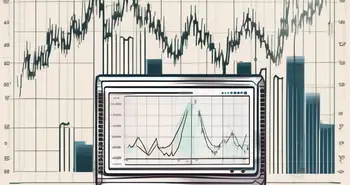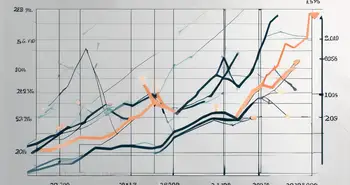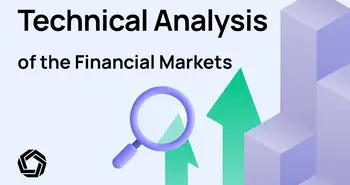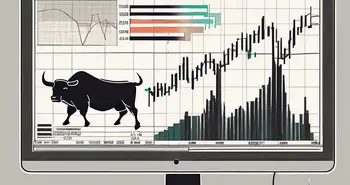Understanding the Significance of the Golden Cross in Financial Markets

As an expert in the field of financial markets, I am often asked about various trading strategies and indicators that can help investors make informed decisions. One concept that has gained significant popularity is the Golden Cross. In this article, we will delve into the significance of the Golden Cross in financial markets and explore its intricacies.
Defining the Golden Cross
The Golden Cross is a technical analysis term used to describe a bullish signal in the stock market. It occurs when a shorter-term moving average, typically the 50-day moving average, crosses above a longer-term moving average, usually the 200-day moving average. This crossover signifies a potential trend reversal, indicating that the stock price may be on an upward trajectory.
When the Golden Cross appears on a stock chart, it often attracts the attention of traders and investors. They see it as a signal that the stock's price may be poised to rise, presenting a potential buying opportunity. However, it is important to note that the Golden Cross is not a foolproof signal and should always be used in conjunction with other indicators and analysis tools. It is merely one piece of the larger puzzle that helps traders make informed decisions.
The Basics of the Golden Cross
At its core, the Golden Cross is a tool used by traders and investors to identify opportunities for entering or exiting positions. When the short-term moving average crosses above the long-term moving average, it suggests that bullish momentum is building, and it may be an opportune time to consider buying stocks.
Traders who use the Golden Cross as part of their strategy often look for confirmation from other technical indicators. They want to ensure that the bullish signal is supported by other factors before making a trading decision. By doing so, they can increase the probability of success and reduce the risk of false signals.
One commonly used indicator in conjunction with the Golden Cross is the Relative Strength Index (RSI). The RSI measures the strength and speed of a stock's price movement and helps traders determine if it is overbought or oversold. When the RSI confirms the Golden Cross by showing that the stock is not overbought, it adds further credibility to the bullish signal.
Another useful indicator to consider alongside the Golden Cross is the Moving Average Convergence Divergence (MACD). The MACD is a trend-following momentum indicator that shows the relationship between two moving averages of a stock's price. When the MACD confirms the Golden Cross by generating a bullish signal, it strengthens the case for a potential uptrend.
Technical Indicators and the Golden Cross
When analyzing the Golden Cross, traders often look at other technical indicators to validate the bullish signal. Some commonly used indicators include the Relative Strength Index (RSI), Moving Average Convergence Divergence (MACD), and Fibonacci retracement levels.
These indicators help traders gauge the strength of the trend and identify potential areas of support and resistance. By combining the Golden Cross with other technical analysis tools, traders can increase the accuracy of their predictions and make more informed trading decisions.
In addition to technical indicators, traders also consider other factors such as market sentiment, company fundamentals, and economic data. These factors provide a broader context for interpreting the Golden Cross and can help traders make more well-rounded decisions.
Furthermore, it is worth noting that the Golden Cross can occur on different timeframes, such as daily, weekly, or monthly charts. Traders may choose to focus on a specific timeframe depending on their trading strategy and investment horizon.
In conclusion, the Golden Cross is a widely recognized bullish signal in technical analysis. It indicates a potential trend reversal and can be a valuable tool for traders and investors. However, it should always be used in conjunction with other indicators and analysis tools to increase the accuracy of predictions and reduce the risk of false signals.
The Role of the Golden Cross in Trading
Now that we understand what the Golden Cross is, let's explore its role in trading and how it can be utilized to maximize profits.
Identifying a Golden Cross in a Chart
Identifying a Golden Cross on a price chart is relatively straightforward. Traders can plot both the short-term and long-term moving averages on the chart and look for a crossover. When the shorter-term moving average crosses above the longer-term moving average, it confirms the presence of a Golden Cross.
However, it is crucial to consider the overall market conditions, as false signals can occur during periods of market volatility. It is always prudent to wait for confirmation through other indicators and analysis tools before making any trading decisions.
Timing Trades with the Golden Cross
Timing is everything in trading, and the Golden Cross can help traders capitalize on potential opportunities. Once a Golden Cross is identified, traders often look for additional confirmation signals, such as an increase in trading volume or a break of a significant resistance level, before entering a position.
Furthermore, some traders use the Golden Cross as an exit signal. When the shorter-term moving average starts to converge with the longer-term moving average, it may indicate the end of the upward trend. These traders use this signal to lock in profits and avoid potential reversals.
The Golden Cross and Market Trends
The Golden Cross can provide valuable insights into market trends and help traders gauge the overall sentiment in the financial markets.
Bullish Signals and the Golden Cross
As mentioned earlier, the Golden Cross is generally considered a bullish signal. When it occurs, it suggests that the stock price has the potential for significant upside movement. This can be particularly useful for traders looking to take advantage of upward trends and capitalize on profitable opportunities.
The Golden Cross and Market Volatility
One criticism of the Golden Cross is its susceptibility to false signals during periods of market volatility. While the Golden Cross can indicate a trend reversal, it is essential to consider other factors such as market sentiment, economic news, and geopolitical events that may impact market volatility.
Traders must exercise caution and employ risk management strategies to mitigate potential losses associated with false signals. Utilizing stop-loss orders and closely monitoring market conditions can help traders protect their investments.
Criticisms and Limitations of the Golden Cross
While the Golden Cross can be a powerful indicator, it is not without its limitations and detractors.
False Signals and the Golden Cross
One of the most significant criticisms of the Golden Cross is the occurrence of false signals. False signals can lead to substantial losses and can be particularly detrimental to inexperienced traders. Therefore, it is crucial to consider other supporting indicators and conduct thorough analysis before making any trading decisions based solely on the Golden Cross.
The Golden Cross and Market Efficiency
Some critics argue that the Golden Cross's popularity has resulted in it becoming less reliable as more traders use it as a basis for their trading decisions. As a result, they believe the market has become more efficient at pricing in the Golden Cross signals, thereby reducing their effectiveness.
It is important for traders to stay informed and adapt their strategies to changing market conditions. Relying solely on a single indicator may not provide optimal results in the long run.
Strategies for Using the Golden Cross
Now that we have explored the concept of the Golden Cross and its limitations, let's discuss strategies for effectively utilizing this indicator.
Combining the Golden Cross with Other Indicators
To increase the accuracy and reliability of predictions, traders often combine the Golden Cross with other technical indicators. For example, using the Golden Cross in conjunction with the RSI can help identify overbought or oversold conditions, strengthening the signal.
By employing multiple indicators, traders can reduce the impact of false signals and make more informed trading decisions.
Risk Management and the Golden Cross
Regardless of the trading strategy employed, risk management is crucial to protect investments. When utilizing the Golden Cross, traders must set appropriate stop-loss orders to limit potential losses in case the trade does not go as expected.
Furthermore, traders should avoid risking a significant portion of their capital on a single trade. Diversifying the portfolio and spreading the risk across multiple assets can help mitigate potential losses and improve overall profitability.
FAQ
What is the Golden Cross?
The Golden Cross is a technical analysis term used to describe a bullish signal in the stock market. It occurs when a shorter-term moving average, such as the 50-day moving average, crosses above a longer-term moving average, typically the 200-day moving average. This crossover signifies a potential trend reversal, suggesting that the stock price may be on an upward trajectory.
How can I identify a Golden Cross on a chart?
To identify a Golden Cross on a price chart, plot both the short-term and long-term moving averages. When the shorter-term moving average crosses above the longer-term moving average, it confirms the presence of a Golden Cross. However, it is advisable to consider other indicators and market conditions to validate the signal.
What are the limitations of the Golden Cross?
One of the limitations of the Golden Cross is the occurrence of false signals, particularly during periods of market volatility. Additionally, the increasing popularity of the Golden Cross has led to some critics questioning its effectiveness, arguing that the market has become more efficient at pricing in these signals.
How should I use the Golden Cross in my trading strategy?
When incorporating the Golden Cross into your trading strategy, it is important to consider other indicators and use proper risk management techniques. Combining the Golden Cross with indicators like the RSI can increase the accuracy of predictions. Additionally, setting appropriate stop-loss orders and diversifying the portfolio can help protect investments and improve overall profitability.
Can the Golden Cross be used in any market?
While the Golden Cross is commonly used in the stock market, it can also be utilized in other financial markets, such as commodities and forex. However, it is vital to adapt the strategy to the specific characteristics and dynamics of each market to ensure optimal results.
As an expert in the field of financial markets, I highly recommend considering the Golden Cross as part of your trading strategy. However, always conduct thorough analysis, utilize other indicators for confirmation, and employ risk management techniques to protect your investments. With the right approach and a keen eye for market trends, the Golden Cross can be a valuable tool in maximizing profits and making informed trading decisions.
Remember, nothing can replace experience and staying informed. Stay updated with market news, economic indicators, and geopolitical events that can impact your trading decisions. With the right knowledge and strategy, you can navigate the financial markets successfully and achieve your investment goals.
Ready to put the Golden Cross strategy into action with a cutting-edge trading platform? Look no further than Morpher, the revolutionary platform that's changing the game with zero fees, infinite liquidity, and the ability to trade a vast array of markets, from stocks to NFTs. Whether you're looking to invest fractionally, short sell without interest fees, or leverage your trades up to 10x, Morpher empowers you with the tools to maximize your trading potential. Experience the future of investing on the Ethereum Blockchain with Morpher. Sign Up and Get Your Free Sign Up Bonus today, and elevate your trading to new heights!

Disclaimer: All investments involve risk, and the past performance of a security, industry, sector, market, financial product, trading strategy, or individual’s trading does not guarantee future results or returns. Investors are fully responsible for any investment decisions they make. Such decisions should be based solely on an evaluation of their financial circumstances, investment objectives, risk tolerance, and liquidity needs. This post does not constitute investment advice.

Painless trading for everyone
Hundreds of markets all in one place - Apple, Bitcoin, Gold, Watches, NFTs, Sneakers and so much more.

Painless trading for everyone
Hundreds of markets all in one place - Apple, Bitcoin, Gold, Watches, NFTs, Sneakers and so much more.









